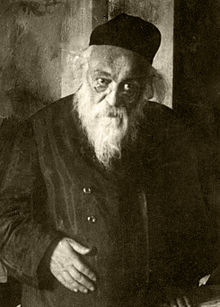Chaim Soloveitchik
This article needs additional citations for verification. (December 2009) |
Chaim Soloveitchik | |
|---|---|
 | |
| Title | Rabbi |
| Personal | |
| Born | March 25, 1853 |
| Died | July 30, 1918 (aged 65) |
| Religion | Judaism |
| Nationality | Belarusian |
| Children | Yitzchok Zev Soloveitchik, Moshe Soloveichik, Yisroel Gershon Soloveichik |
| Parents |
|
| Denomination | Orthodox Judaism |
| Yahrtzeit | 21 Av 5678 |
| Buried | Jewish Cemetery, Warsaw |
| Dynasty | Soloveitchik dynasty |
Chaim (Halevi) Soloveitchik (Yiddish: חיים סאָלאָווייטשיק, Polish: Chaim Sołowiejczyk), also known as Reb Chaim Brisker (1853 – 30 July 1918), was a rabbi and Talmudic scholar credited as the founder of the popular Brisker approach to Talmudic study within Judaism. He is also a member of the Soloveitchik dynasty, as the son of the Beis HaLevi.[1]
Biography
Soloveitchik was born in Volozhin on March 25, 1853, where his father, Rabbi Yosef Dov Soloveitchik served as a lecturer in the famous Volozhiner Yeshiva.[1][2] Prior to his birth, Soloveitchik's father was passed for the position of Rosh yeshiva at the Volozhiner Yeshiva, in favor of Naftali Tzvi Yehuda Berlin in 1854, ultimately resulting in their family moving away from Volozhin.[3] After a few years, his father was appointed as a rabbi in Slutzk, where young Chaim was first educated.[4] While still a youngster, his genius and lightning-quick grasp were widely recognized.
Despite Soloveitchik's father leaving the yeshiva, Berlin would request that Soloveitchik return as a member of the faculty of the Yeshiva in 1880, later requesting that he become assistant Rosh yeshiva alongside him.[3] This would not last long, however, as the Russian Empire, forced the yeshiva to close, resulting in Soloveitchik moving to Brisk, Belarus and succeeding his father as the rabbinate of Brisk.[4][5]
Soloveitchik was buried in Warsaw, in the Jewish Cemetery, having died on July 30, 1918 after seeking medical treatment in that area.[6][7][8]

Works
He is considered the founder of the "Brisker method" (in Yiddish: Brisker derech; Hebrew: derekh brisk), a method of highly exacting and analytical Talmudical study that focuses on precise definition/s and categorization/s of Jewish law as commanded in the Torah.[6][9] His works would have particular emphasis on the legal writings of Maimonides.[10][11]
Soloveitchik's primary work was Chiddushei Rabbeinu Chaim, a volume of insights on Maimonides' Mishneh Torah which often would suggest novel understandings of the Talmud as well.[12] Based on his teachings and lectures, his students wrote down his insights on the Talmud known as Chiddushi HaGRaCh Al Shas. This book is known as "Reb Chaim's stencils" and contains analytical insights into Talmudic topics.
Views
Soloveitchik would work alongside Sholom Dovber Schneersohn, the fifth Lubavitch Rebbe, specifically for his work in counteracting antisemitic decrees by the czarist regime.[10][13] He would expand the definition of who represented Amalek, claiming that all who sought to destroy the Jewish people were ideological decedents of the Jewish enemy.[14]
Family
A member of the Soloveitchik-family rabbinical dynasty, he is commonly known as Reb Chaim Brisker ("Rabbi Chaim [from] Brisk").
He married the daughter of Refael Shapiro, who was also the granddaughter of Berlin,[3] and had two famous sons, Yitchak Zev (also known as Rabbi Velvel Soloveitchik) who subsequently moved to Israel and Moshe who moved to the United States and subsequently served as a rosh yeshiva of Yeshiva Yitzchak Elchonon (YU/RIETS) in New York and who was in turn succeeded by his sons Joseph B. Soloveitchik (1903–1993) and Ahron Soloveichik (1917-2001). Yitchak Zev's son, Meshulam Dovid Soloveitchik, heads a renowned yeshiva in Jerusalem; two of his other sons, Meir and Yosef Dov Soloveitchik, also led prominent yeshivas.[1]
Soloveitchik had eight main students; his sons Moshe and Yitzchak Zev, Baruch Ber Lebowitz, Isser Zalman Meltzer, Elchonon Wasserman, Shlomo Polachek, Chaim Ozer Grodzinski and Shimon Shkop.
| |||||||||||||||||||||||||||||||||||||||||||||||||||||||||||||||||||||||||||||||||||||||||||||||||||||||||||||||||||||||||||||||||||||||||||||||||||||||||||||||||||||||||||||||||||||||||||||||||||||||||||||||||||||||||||||||||||||||||||||||||||||||||||||||||||||||||||||||||||||||||||||||||||||||||||||||||||||||||||||||||||||||||||||||||||||||||||||||||||||||||||||||||||||||||||||||||||||||||||||||||||||||||||||||||||||||||||||||||||||||||||||||||||||||||||||||||||||||||||||||||||||||||||||||||||||||||||||||||||||||||||||||||||||||||||||||||||||||||||||||||||||||||||||||||||||||||||||||||||||||||||||||||||||||||||||||||||||||||||||||||||||||||||||||||||||||||||||||||||||||||||||||||||||||||||||||||||||||||||||||||||||||||||||||||||||||||||||||||||||||||||||||||||||||||||||||||||||||||||||||||||||||||||||||||||||||||||||||||||||||||||||||||||||||||||||||||||||||||||||||||||||||||||||||||||||||||||||||||||||||||||||||||||||||||||||||||||||||||||||||||||||||||||||||||||||||||||||||||||||||
| Notes:
| |||||||||||||||||||||||||||||||||||||||||||||||||||||||||||||||||||||||||||||||||||||||||||||||||||||||||||||||||||||||||||||||||||||||||||||||||||||||||||||||||||||||||||||||||||||||||||||||||||||||||||||||||||||||||||||||||||||||||||||||||||||||||||||||||||||||||||||||||||||||||||||||||||||||||||||||||||||||||||||||||||||||||||||||||||||||||||||||||||||||||||||||||||||||||||||||||||||||||||||||||||||||||||||||||||||||||||||||||||||||||||||||||||||||||||||||||||||||||||||||||||||||||||||||||||||||||||||||||||||||||||||||||||||||||||||||||||||||||||||||||||||||||||||||||||||||||||||||||||||||||||||||||||||||||||||||||||||||||||||||||||||||||||||||||||||||||||||||||||||||||||||||||||||||||||||||||||||||||||||||||||||||||||||||||||||||||||||||||||||||||||||||||||||||||||||||||||||||||||||||||||||||||||||||||||||||||||||||||||||||||||||||||||||||||||||||||||||||||||||||||||||||||||||||||||||||||||||||||||||||||||||||||||||||||||||||||||||||||||||||||||||||||||||||||||||||||||||||||||||||
References
- ^ a b c "Rabbi Chaim "Brisker" Soloveitchik". geni_family_tree. Retrieved 2020-08-05.
- ^ Gefen, Yehonasan (Jun 29, 2020). "Parshat Chukat: The Importance of Forgiveness". aishcom. Retrieved 2020-08-05.
{{cite web}}: CS1 maint: url-status (link) - ^ a b c Schloss, Chaim (2002). 2000 Years of Jewish History: From the Destruction of the Second Bais Hamikdash Until the Twentieth Century. Feldheim Publishers. ISBN 978-1-58330-214-9.
- ^ a b Wolkenfeld, David. "Rabbi Hayyim Soloveitchik of Brisk". www.sefaria.org. Retrieved 2020-08-10.
{{cite web}}: CS1 maint: url-status (link) - ^ Zevin, S. Y. (1966). Ishim v'Shittos. Tel Aviv: A. Tsiyoni. p. 43. OCLC 19197943.
- ^ a b "Rabbi Chaim Halevi "The Brisker" Soloveichik..." www.findagrave.com. Retrieved 2020-08-07.
- ^ The Bones of Brisk
- ^ Tercatin, Rossella (July 22, 2020). "Unexploded Nazi mortar uncovered in 'Warsaw Ghetto' Jewish cemetery". The Jerusalem Post | JPost.com. Retrieved 2020-08-07.
{{cite web}}: CS1 maint: url-status (link) - ^ Similarities in Criticism of the Methods and Responses. Vol. vol 7-8. San Diego: University of San Diego School of Law. 2005.
{{cite book}}:|volume=has extra text (help);|work=ignored (help)CS1 maint: date and year (link) - ^ a b Rubin, Eli; Rubin, Mordechai. "Rabbi Chaim Soloveitchik of Brisk - Marking 100 Years Since His Passing". www.chabad.org. Retrieved 2020-08-07.
{{cite web}}: CS1 maint: url-status (link) - ^ Zakon, Nachman (2002). The Jewish Experience--2000 Years: A Collection of Significant Events. Shaar Press. ISBN 978-1-57819-496-4.
- ^ BERGER, DAVID (2011), "THE USES OF MAIMONIDES BY TWENTIETH-CENTURY JEWRY", Cultures in Collision and Conversation, Essays in the Intellectual History of the Jews, Academic Studies Press, pp. 190–202, ISBN 978-1-936235-24-7, retrieved 2020-08-07
- ^ Butman, Shmuel (March 19, 2020). "The 'Rambam Of Chassidus'". Retrieved 2020-08-08.
{{cite web}}: CS1 maint: url-status (link) - ^ Firestone, Reuven (2012-07-02). Holy War in Judaism: The Fall and Rise of a Controversial Idea. Oxford University Press. ISBN 978-0-19-997715-4.
External links
 |

